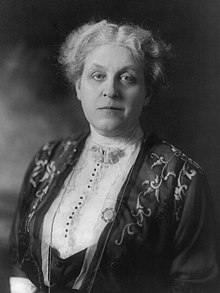Carrie Chapman Catt: Difference between revisions
Binksternet (talk | contribs) m Reverted 2 edits by 63.166.157.87 identified as vandalism to last revision by PhilKnight. (TW) |
|||
| Line 58: | Line 58: | ||
[[fr:Carrie Chapman Catt]] |
[[fr:Carrie Chapman Catt]] |
||
this is very boring learning about her |
|||
Revision as of 17:49, 5 May 2010
Carrie Chapman Catt | |
|---|---|
 | |
| Born | January 9, 1859 |
| Died | March 9, 1947 (aged 88) |
Carrie Chapman Catt (January 9, 1859 – March 9, 1947) was a women's suffrage leader who campaigned for the Nineteenth Amendment to the United States Constitution which gave U.S. women the right to vote in 1920. Catt served as president of the National American Woman Suffrage Association and was the founder of the League of Women Voters and the International Alliance of Women.
Biography

She was born Carrie Clinton Lane in Ripon, Wisconsin. Catt spent her childhood in Charles City, Iowa and graduated from Iowa State College (later called Iowa State University) in Ames, Iowa, graduating in three years. She was the valedictorian of her class, and the only woman.[1] She became a teacher and then superintendent of schools in Mason City, Iowa in 1885.
In 1885 Carrie married newspaper editor Leo Chapman, but he died in California soon after. Eventually she landed on her feet but only after some harrowing experiences in the male working world. In 1890, she married George Catt, a wealthy engineer. Their marriage allowed her to spend a good part of each year on the road campaigning for women's suffrage, a cause she had become involved with in Iowa during the late 1880s. Catt also joined the Women's Christian Temperance Union.
Catt became a close colleague of Susan B. Anthony, who selected Catt to succeed her as head of the National American Woman Suffrage Association (NAWSA). She was elected president of NAWSA twice; her first term was from 1900 to 1904 and her second term was from 1915 to 1920. Her second term coincided with the climax of the women's suffrage movement in the U.S., and culminated in the adoption of the Nineteenth Amendment to the U.S. Constitution in 1920. NAWSA was by far the largest organization working for women's suffrage in the U.S. From her first endeavors in Iowa in the 1880s to her last in Tennessee in 1920, Catt supervised dozens of campaigns, mobilized numerous volunteers (1 million by the end), and made hundreds of speeches. After the passage of the Nineteenth Amendment to the United States Constitution, Catt retired from NAWSA. [2]
Catt founded the League of Women Voters in 1920 as a successor to NAWSA. In the same year, she ran as the Presidential candidate for the Commonwealth Land Party. [3]

Catt was also a leader of the international women's suffrage movement. [4] She helped to found the International Woman Suffrage Alliance (IWSA) in 1902, serving as its president from 1904 until 1923. The IWSA remains in existence, now as the International Alliance of Women.
Catt was active in anti-war causes during the 1920s and 1930s. She settled in New Rochelle, New York in 1928. During this period she was frequently recognized as one of the most prominent female leaders of her time. Carrie Chapman Catt died in New Rochelle in 1947 and was interred at Woodlawn Cemetery, Bronx, NY.
See also
Notes
- ^ "Carrie Lane Chapman Catt". Traditions. ISU Alumni Association. Retrieved March 15, 2010.
- ^ [Women in Congress, 1917-1990, DIANE Publishing Company, page.208]
- ^ Excerpt from The Corruption of Economics by Mason Gaffney
- ^ [Carrie Chapman Catt: A Life of Leadership,by Nate Levin,page.62]
References
- Robert Booth Fowler, Carrie Catt: Feminist Politician (1986).
- Jacqueline Van Voris, Carrie Chapman Catt: A Public Life (1996).
- Mary Gray Peck, Carrie Chapman Catt: A Biography (1944).
- Nate Levin, Carrie Chapman Catt: A Life of Leadership (2006).
External links
- The Carrie Chapman Catt Girlhood Home and Museum online, located in Charles City, Iowa
- PBS Kids: Women and the Vote [1]
- Information from the Library of Congress [2] [3]
- About.com [4]
- Interesting Timeline showing the different tactics of the National Woman’s Party and the National American Woman Suffrage Association [5]
- Alice Paul Institute [6]
- Biography by Women in History (an organization in Ohio) [7]
- Carrie Chapman Catt at Find a Grave
this is very boring learning about her
